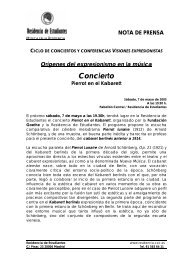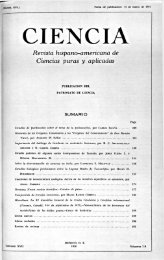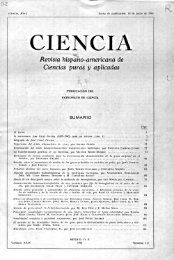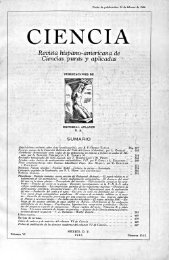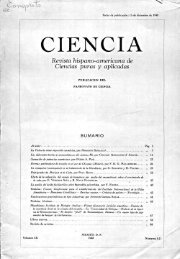CIENCIA - Consejo Superior de Investigaciones Científicas
CIENCIA - Consejo Superior de Investigaciones Científicas
CIENCIA - Consejo Superior de Investigaciones Científicas
You also want an ePaper? Increase the reach of your titles
YUMPU automatically turns print PDFs into web optimized ePapers that Google loves.
Localidad.—México: Cueva «le la Bina, que<br />
se able en el Bar-amo <strong>de</strong>l Río Huajutci, a tilrl) m<br />
<strong>de</strong> all., a (i Km al NE <strong>de</strong> Villa <strong>de</strong> Santiago. Es<br />
tado «le Nuevo León, IS-VII-1942, C. Bolivar,<br />
M. Maldona«lo-K«ier<strong>de</strong>ll, B. Osorio Talall \<br />
I). I'eláe/, 12 ejemplares. De la misma gruía<br />
existen 7 ejemplares más capturados |«>r E. Bo<br />
nd en I7-VI-I944.<br />
Visitada «le nuevo la cueva en 18-1^-1959,<br />
pOr C. y S. Bolívar, A. Gómez, F. Aguilar \<br />
I). Fuentes, se recogió 1 ejemplar más <strong>de</strong> Win-<br />
dine.<br />
La cueva, Ubicada a poto más <strong>de</strong> .10 Km en<br />
linea recta «leí centro <strong>de</strong> la ciudad «le Monte-<br />
trey. se advierte <strong>de</strong>s<strong>de</strong> lejos al ascen<strong>de</strong>r el ba<br />
rranco <strong>de</strong>l Rio Huajuco, cuyas aguas han sido<br />
hoy embalsadas en una gran presa, y se eleva<br />
150 m sobre la carretera Villa «le Santiago-Ca<strong>de</strong><br />
reyla, «pie atraviesa el cañón «leí Río Huajuto.<br />
Des<strong>de</strong> hace años la gruta es explotada «orno<br />
mina, lo «pie ha originado «pie esté muy tras-<br />
tocada Unía su parle anterior, en la «pie antes<br />
se encontraba en gran abundancia R. boneli,<br />
aun en -«liciones parcialmente iluminadas, so<br />
bre la tierra o guano en «pie busca sus presas.<br />
El carábido, sigue sin embargo existiendo, pero<br />
se llalla en las galerías más obscuras y profun<br />
das «le la caverna, tpte es relativamente gran<strong>de</strong>.<br />
Observaciones.—De las especies estudiadas por<br />
nosotros es la que tiene menos acusadas algunas<br />
<strong>de</strong> las peculiarida<strong>de</strong>s <strong>de</strong> Rliadine como son en<br />
especial la carencia «le sedas supraorbital!-.* ante<br />
riores tpte la separa induso «le to«los los Ago-<br />
nini Son también notables la pr«>porc¡ón niavor<br />
anchura/longitud <strong>de</strong> la cabeza y «leí pronoto; la<br />
pigmentación es sensiblemente más intensa, el<br />
porte mucho más robusto, y la <strong>de</strong>hiscencia elitral<br />
casi nula, y carece |x>r completo «le sedas pre<br />
nótales.<br />
Es la más próxima a /«". pelaezi por su facies<br />
robusta, |x;ro se distingue muy fácilmente por<br />
la quetotaxia «le cabe/a y pronoto.<br />
SUMMARY<br />
Four new cavernicolous Agonini of the North<br />
eastern part of Mexico are <strong>de</strong>scribed including<br />
them in the Genus Rhadine, which other authors<br />
have used in genera acception since I.eCont,<br />
as Casey, |eannel. Benedicl and San<strong>de</strong>rson<br />
Miller.<br />
The 4 species were collected in the Stales of<br />
Nuevo I.eon (2 of litem), Coaluiila ami San Luis<br />
Potosí at explorations ma<strong>de</strong> during the last<br />
C. I F. N C. I A<br />
20 years, mainly by one of the authors (Boli<br />
var) from the Eacuela National dcCien



